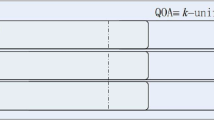Abstract
An \(N \times k\) array A with entries from v-set \({\mathcal {V}}\) is said to be an orthogonal array with v levels, strength t and index \(\lambda \), denoted by OA(N; t, k, v), if every \(N \times t\) sub-array of A contains each t-tuple based on \({\mathcal {V}}\) exactly \(\lambda \) times as a row. An OA(N; t, k, v) is called irredundant, denoted by IrOA(N; t, k, v), if in any \(N\times (k-t )\) sub-array, all of its rows are different. The definition of an IrOA was firstly introduced by Goyeneche and \({\dot{Z}}\)yczkowski (Phys Rev A 90:022316, 2014) who showed an IrOA(N; t, k, v) corresponds to a t-uniform state of k subsystems with local dimension v. In this paper, we construct some kinds of 2-uniform states by establishing the existence of an IrOA\((v^3;2,12,v)\) for any integer \((v\ge 4)\) and \((v\not \equiv 2\pmod 4)\), and an IrOA\((v^3;2,3v,v)\) for any prime or prime power \(v\ge 3\).
Similar content being viewed by others
References
Bennett, C.H.: Quantum cryptography using any two nonorthogonal states. Phys. Rev. Lett. 68, 3121–3124 (1992)
Bennett, C.H., Brassard, G., Crépeau, C., Jozsa, R., Peres, A., Wootters, W.K.: Teleporting an unknown quantum state via dual classical and Einstein–Podolsky–Rosen channels. Phys. Rev. Lett. 70, 1895–1899 (1993)
Bouwmeester, D., Pan, J.W., Mattle, K., Eibl, M., Weinfurter, H., Zeilinger, A.: Experimental quantum teleportation. Nature 390, 575–579 (1997)
Colbourn, C.J., Dinitz, J.H.: The CRC Handbook of Combinatorial Designs. CRC Press, Boca Raton (2007)
Dey, A., Mukerjee, R.: Fractional Factorial Plans. Wiley, New York (1999)
Ekert, A.K.: Quantum cryptography based on bells theorem. Phys. Rev. Lett. 67(6), 661–663 (1991)
Facchi, P.: Multipartite entanglement in qubit systems. Rend. Lincei Mat. Appl. 20, 25–67 (2009)
Facchi, P., Florio, G., Parisi, G., Pascazio, S.: Maximally multipartite entangled states. Phys. Rev. A 77, 060304 (2008)
Feng, K.Q., Jin, L.F., Xing, C.P., Yuan, C.: Multipartite entangled states, symmetric matrices and error-correcting codes. IEEE Trans. Inf. Theory 63, 5618–5627 (2017)
Ge, G.: On (g,4;1)-difference matrices. Discrete Math. 301(2), 164–174 (2005)
Goyeneche, D., Raissi, Z., Martino, S.D., Życzkowski, K.: Entanglement and quantum combinatorial designs. Phys. Rev. A 97(6), 062326 (2018)
Goyeneche, D., Życzkowski, K.: Genuinely multipartite entangled states and orthogonal arrays. Phys. Rev. A 90, 022316 (2014)
Hedayat, A.S., Sloane, N.J.A., Stufken, J.: Orthogonal Arrays: Theory and Applications. Springer, NewYork (1999)
Helwig, W.: Absolutely maximally entangled qudit graph states. Preprint, arXiv:1306.2879v1
Helwig, W., Cui, W., Latorre, J.I., Riera, A., Lo, H.K.: Absolute maximal entanglement and 4 quantum secret sharing. Phys. Rev. A 86, 052335 (2012)
Horodecki, R., Horodecki, P., Horodecki, M., Horodecki, K.: Quantum entanglement. Rev. Mod. Phys. 81(2), 865–942 (2009)
Horodecki, P., Rudnicki, Ł., Życzkowski, K.: Five open problems in quantum information. Preprint, arXiv:2002.03233v1
Ji, L., Yin, J.: Constructions of new orthogonal arrays and covering arrays of strength three. J. Comb. Theory Ser. A 117(3), 236–247 (2010)
Jozsa, R., Linden, N.: On the role of entanglement in quantum computational speed-up. Proc. R. Soc. A 459, 2011–2032 (2003)
Li, M.S., Wang, Y.L.: \(k\)-uniform quantum states arising from orthogonal arrays. Phy. Rev. A 99, 042332 (2019)
Lo, H.K., Curty, M., Qi, B.: Measurement-device-independent quantum key distribution. Phys. Rev. Lett. 108, 130503 (2012)
Pang, S.Q., Zhang, X., Lin, X., Zhang, Q.J.: Two and three-uniform states from irredundant orthogonal arrays. npj Quantum Inf. 5, 1–10 (2019)
Pastawski, F., Yoshida, B., Harlow, D., Preskill, J.: Holographic quantum error-correcting codes: toy models for the bulk/boundary correspondence. J. High Energy Phys. 6, 149 (2015)
Rao, C.R.: Factorial experiments derivable from combinational arrangements of arrays. J. R. Stat. Soc. 9, 128–139 (1947)
Riebe, M., Haffner, H., Roos, F.C., et al.: Deterministic quantum teleportation with atoms. Nature 429, 734–737 (2004)
Roos, C.F., Riebe, M., Haffner, H., et al.: Control and measurement of three-qubit entangled states. Science 304(5676), 1478–1480 (2004)
Scott, A.J.: Multipartite entanglement, quantum-error-correcting codes, and entangling power of quan-tum evolutions. Phys. Rev. A 69, 052330 (2004)
Shi, F., Shen, Y., Chen, L., Zhang, X.: Constructions of k-uniform states from mixed orthogonal arrays. arXiv:2006.04086v1
Zang, Y.J., Chen, G.Z., Chen, K.J., Tian, Z.H.: Further results on 2-uniform states arising from irredundant orthogonal arrays. In: Advances in Mathematics of Communications (published online). https://doi.org/10.3934/amc.2020109
Zang, Y.J., Zuo, H.J., Tian, Z.H.: 3-uniform states and orthogonal arrays of strength 3. Int. J. Quantum Inf. 17, 1950003 (2019)
Zha, X.W., Ahmed, I., Zhang, Y.P.: 3-uniform states and orthogonal arrays. Results Phys. 6, 26–28 (2016)
Zha, X.W., Yuan, C.Z., Zhang, Y.P.: Generalized criterion for a maximally multi-qubit entangled states. Laser Phys. Lett. 10, 045201 (2013)
Zhao, Z., et al.: Experimental demonstration of five-photon entanglement and open-destination teleportation. Nature 430(6995), 54–58 (2004)
Author information
Authors and Affiliations
Corresponding author
Additional information
Publisher's Note
Springer Nature remains neutral with regard to jurisdictional claims in published maps and institutional affiliations.
Supported by National Natural Science Foundation of China (Grant Nos. 11871417 and 11501181).
Rights and permissions
About this article
Cite this article
Chen, G., Zhang, X. & Guo, Y. New results for 2-uniform states based on irredundant orthogonal arrays. Quantum Inf Process 20, 43 (2021). https://doi.org/10.1007/s11128-020-02978-x
Received:
Accepted:
Published:
DOI: https://doi.org/10.1007/s11128-020-02978-x




